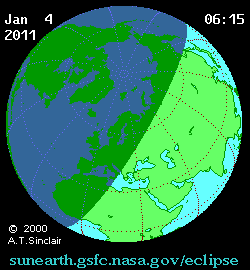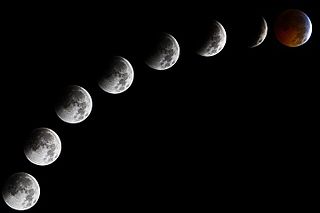
- Peak Date = May 6













| Duration (hr:mn:sc) | |
|---|---|
| Totality | 1:13:12 |
| Partial | 3:29:22 |
| Penumbral | 5:38:22 |
 |
| The Phases of the Eclipse |


| Messier No. | NGC No. | Common Name | Constellation | Apparent Magnitude | Object type |
| M1 | NGC 1952 | Crab Nebula | Taurus | 9.0 | Supernova remnant |
| M2 | NGC 7089 | | Aquarius | 7.5 | Globular cluster |
| M3 | NGC 5272 | | Canes Venatici | 7.0 | Globular cluster |
| M4 | NGC 6121 | | Scorpius | 7.5 | Globular cluster |
| M5 | NGC 5904 | | Serpens | 7.0 | Globular cluster |
| M6 | NGC 6405 | Butterfly Cluster | Scorpius | 4.5 | Open cluster |
| M7 | NGC 6475 | Ptolemy Cluster | Scorpius | 3.5 | Open cluster |
| M8 | NGC 6523 | Lagoon Nebula | Sagittarius | 6.0 | Cluster with nebula |
| M9 | NGC 6333 | | Ophiuchus | 9.0 | Globular cluster |
| M10 | NGC 6254 | | Ophiuchus | 7.5 | Globular cluster |
| M11 | NGC 6705 | Wild Duck Cluster | Scutum | 7.0 | Open cluster |
| M12 | NGC 6218 | | Ophiuchus | 8.0 | Globular cluster |
| M13 | NGC 6205 | Great Globular Cluster in Hercules | Hercules | 5.8 | Globular cluster |
| M14 | NGC 6402 | | Ophiuchus | 9.5 | Globular cluster |
| M15 | NGC 7078 | Cúmulo de Pegaso | Pegasus | 7.5 | Globular cluster |
| M16 | NGC 6611 | Eagle Nebula | Serpens | 6.5 | Cluster with H II region |
| M17 | NGC 6618 | Horseshoe Nebula | Sagittarius | 6.0 | Cluster with H II region |
| M18 | NGC 6613 | | Sagittarius | 8.0 | Open cluster |
| M19 | NGC 6273 | | Ophiuchus | 8.5 | Globular cluster |
| M20 | NGC 6514 | Trifid Nebula | Sagittarius | 6.3 | Cluster with H II region |
| M21 | NGC 6531 | | Sagittarius | 7.0 | Open cluster |
| M22 | NGC 6656 | Sagittarius Cluster | Sagittarius | 5.1 | Globular cluster |
| M23 | NGC 6494 | | Sagittarius | 6.0 | Open cluster |
| M24 | NGC 6603 | Sagittarius Star Cloud | Sagittarius | 4.6 | Milky Way star cloud |
| M25 | IC 4725 | | Sagittarius | 4.9 | Open cluster |
| M26 | NGC 6694 | | Scutum | 9.5 | Open cluster |
| M27 | NGC 6853 | Dumbbell Nebula | Vulpecula | 7.5 | Planetary nebula |
| M28 | NGC 6626 | | Sagittarius | 8.5 | Globular cluster |
| M29 | NGC 6913 | | Cygnus | 9.0 | Open cluster |
| M30 | NGC 7099 | | Capricornus | 8.5 | Globular cluster |
| M31 | NGC 224 | Andromeda Galaxy | Andromeda | 3.4 | Spiral galaxy |
| M32 | NGC 221 | | Andromeda | 10.0 | Dwarf elliptical galaxy |
| M33 | NGC 598 | Triangulum Galaxy | Triangulum | 5.7 | Spiral galaxy |
| M34 | NGC 1039 | | Perseus | 6.0 | Open cluster |
| M35 | NGC 2168 | | Gemini | 5.5 | Open cluster |
| M36 | NGC 1960 | | Auriga | 6.5 | Open cluster |
| M37 | NGC 2099 | | Auriga | 6.0 | Open cluster |
| M38 | NGC 1912 | | Auriga | 7.0 | Open cluster |
| M39 | NGC 7092 | | Cygnus | 5.5 | Open cluster |
| M40 | | Winnecke 4 | Ursa Major | 9.0 | Double star WNC4 |
| M41 | NGC 2287 | | Canis Major | 4.5 | Open cluster |
| M42 | NGC 1976 | Orion Nebula | Orion | 4.0 | H II region |
| M43 | NGC 1982 | De Mairan's Nebula | Orion | 7.0 | H II region |
| M44 | NGC 2632 | Beehive Cluster | Cancer | 3.7 | Open cluster |
| M45 | | Pleiades | Taurus | 1.6 | Open cluster |
| M46 | NGC 2437 | | Puppis | 6.5 | Open cluster |
| M47 | NGC 2422 | | Puppis | 4.5 | Open cluster |
| M48 | NGC 2548 | | Hydra | 5.5 | Open cluster |
| M49 | NGC 4472 | | Virgo | 10.0 | Elliptical galaxy |
| M50 | NGC 2323 | | Monoceros | 7.0 | Open cluster |
| M51 | NGC 5194, 5195 | Whirlpool Galaxy | Canes Venatici | 8.4 | Spiral galaxy |
| M52 | NGC 7654 | | Cassiopeia | 8.0 | Open cluster |
| M53 | NGC 5024 | | Coma Berenices | 8.5 | Globular cluster |
| M54 | NGC 6715 | | Sagittarius | 8.5 | Globular cluster |
| M55 | NGC 6809 | | Sagittarius | 7.0 | Globular cluster |
| M56 | NGC 6779 | | Lyra | 9.5 | Globular cluster |
| M57 | NGC 6720 | Ring Nebula | Lyra | 8.8 | Planetary nebula |
| M58 | NGC 4579 | | Virgo | 11.0 | Barred spiral galaxy |
| M59 | NGC 4621 | | Virgo | 11.5 | Elliptical galaxy |
| M60 | NGC 4649 | | Virgo | 10.5 | Elliptical galaxy |
| M61 | NGC 4303 | | Virgo | 10.5 | Spiral galaxy |
| M62 | NGC 6266 | | Ophiuchus | 8.0 | Globular cluster |
| M63 | NGC 5055 | Sunflower Galaxy | Canes Venatici | 8.5 | Spiral galaxy |
| M64 | NGC 4826 | Black Eye Galaxy | Coma Berenices | 9.0 | Spiral galaxy |
| M65 | NGC 3623 | | Leo | 10.5 | Barred spiral galaxy |
| M66 | NGC 3627 | | Leo | 10.0 | Barred spiral galaxy |
| M67 | NGC 2682 | | Cancer | 7.5 | Open cluster |
| M68 | NGC 4590 | | Hydra | 9.0 | Globular cluster |
| M69 | NGC 6637 | | Sagittarius | 9.0 | Globular cluster |
| M70 | NGC 6681 | | Sagittarius | 9.0 | Globular cluster |
| M71 | NGC 6838 | | Sagitta | 8.5 | Globular cluster |
| M72 | NGC 6981 | | Aquarius | 10.0 | Globular cluster |
| M73 | NGC 6994 | | Aquarius | 9.0 | Asterism |
| M74 | NGC 628 | | Pisces | 10.5 | Spiral galaxy |
| M75 | NGC 6864 | | Sagittarius | 9.5 | Globular cluster |
| M76 | NGC 650, 651 | Little Dumbbell Nebula | Perseus | 10.1 | Planetary nebula |
| M77 | NGC 1068 | | Cetus | 10.5 | Spiral galaxy |
| M78 | NGC 2068 | | Orion | 8.0 | Diffuse nebula |
| M79 | NGC 1904 | | Lepus | 8.5 | Globular cluster |
| M80 | NGC 6093 | | Scorpius | 8.5 | Globular cluster |
| M81 | NGC 3031 | Bode's Galaxy | Ursa Major | 6.9 | Spiral galaxy |
| M82 | NGC 3034 | Cigar Galaxy | Ursa Major | 9.5 | Barred spiral galaxy |
| M83 | NGC 5236 | Southern Pinwheel Galaxy | Hydra | 8.5 | Barred spiral galaxy |
| M84 | NGC 4374 | | Virgo | 11.0 | Lenticular galaxy |
| M85 | NGC 4382 | | Coma Berenices | 10.5 | Lenticular galaxy |
| M86 | NGC 4406 | | Virgo | 11.0 | Lenticular galaxy |
| M87 | NGC 4486 | | Virgo | 11.0 | Elliptical galaxy |
| M88 | NGC 4501 | | Coma Berenices | 11.0 | Spiral galaxy |
| M89 | NGC 4552 | | Virgo | 11.5 | Elliptical galaxy |
| M90 | NGC 4569 | | Virgo | 11.0 | Spiral galaxy |
| M91 | NGC 4548 | | Coma Berenices | 11.0 | Barred Spiral galaxy |
| M92 | NGC 6341 | | Hercules | 7.5 | Globular cluster |
| M93 | NGC 2447 | | Puppis | 6.5 | Open cluster |
| M94 | NGC 4736 | | Canes Venatici | 9.5 | Spiral galaxy |
| M95 | NGC 3351 | | Leo | 11.0 | Barred Spiral galaxy |
| M96 | NGC 3368 | | Leo | 10.5 | Spiral galaxy |
| M97 | NGC 3587 | Owl Nebula | Ursa Major | 9.9 | Planetary nebula |
| M98 | NGC 4192 | | Coma Berenices | 11.0 | Spiral galaxy |
| M99 | NGC 4254 | | Coma Berenices | 10.5 | Spiral galaxy |
| M100 | NGC 4321 | | Coma Berenices | 10.5 | Spiral galaxy |
| M101 | NGC 5457 | Pinwheel Galaxy | Ursa Major | 7.9 | Spiral galaxy |
| M102 | -------------- | | | | |
| M103 | NGC 581 | | Cassiopeia | 7.0 | Open cluster |
| M104 | NGC 4594 | Sombrero Galaxy | Virgo | 9.5 | Spiral galaxy |
| M105 | NGC 3379 | | Leo | 11.0 | Elliptical galaxy |
| M106 | NGC 4258 | | Canes Venatici | 9.5 | Spiral galaxy |
| M107 | NGC 6171 | | Ophiuchus | 10.0 | Globular cluster |
| M108 | NGC 3556 | | Ursa Major | 11.0 | Spiral galaxy |
| M109 | NGC 3992 | | Ursa Major | 11.0 | Barred Spiral galaxy |
| M110 | NGC 205 | | Andromeda | 10.0 | Dwarf elliptical galaxy |
